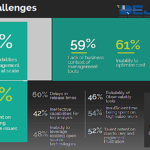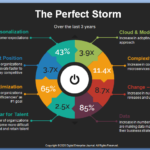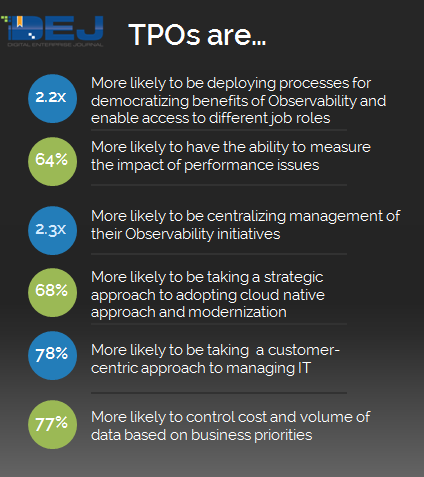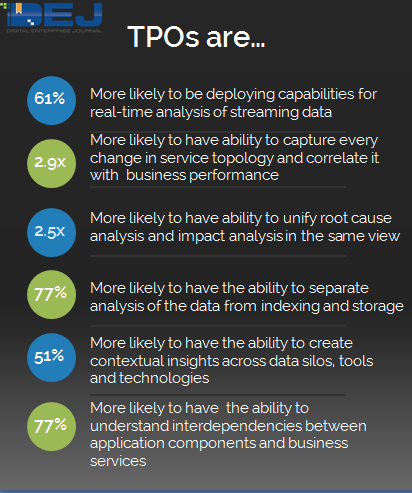Digital Enterprise Journal (DEJ) just published a market study on Strategies of Leading Organizations in Adopting Observability. The study is based on insights from more than 1,300 organizations and was not sponsored by any vendors. The key goals of the study were to: 1) determine what Observability really means to user organizations (beyond vendors’ marketing and being a buzzword); 2) identify the true value areas of Observability; 3) allow organizations to benchmark their performance and identify a class of top performing organizations: 4) analyze capabilities that are having the most impact on performance; and 5) provide data-backed recommendations for achieving performance levels of leading organizations in adopting Observability.
The study includes a variety of topics around adopting Observability and this article summarizes DEJ’s 10 key takeaways from this research.
1 – There is no true Observability without the business context. The study shows that an impact on business outcomes is the #1 criteria for selecting Observability solutions. However, 59% of organizations reported a lack of business context of Observability solutions as a key challenge. TPOs are 52% more likely to be adopting Observability to understand the business context of IT performance and, as a result, are generating 4.6 times more revenue from new digital services, as compared to all others.
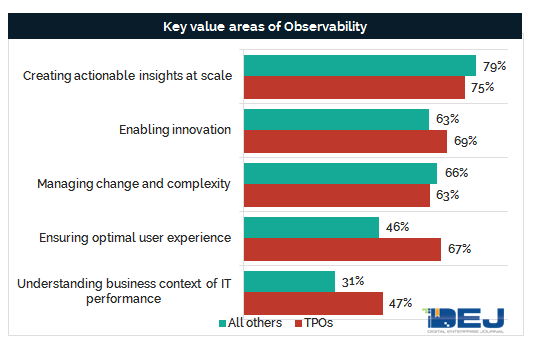
2- Observability data management is the key enabler of top performing organizations. The #1 challenge for Observability, as reported by 69% of organizations, is a lack of capabilities for data management and analysis at scale. This drives a number of additional pain points, such as the inability to optimize cost (61%), lack of actionable context (70%), inefficient process for routing data from source to destination (59%), query time and time-to-insight (51%). The study shows that TPOs are 3.3 times more likely to have defined strategies for Observability data management. As a result, these organizations are 80% more likely to report that having more data helps with improving visibility into their environments and creating actionable insights. On the other hand, 56% of all other organizations reported increasing amounts of data as one of the key challenges.
3 – It’s all about delivering differentiating user experiences. The study found that delivering exceptional digital experiences is the #1 goal for adopting Observability (68% of organizations). Also, 69% of business and technology executives are looking to adopt Observability to enable using technology as a source of competitive advantage. Organizations should be measuring their success in adopting Observability, not by using DORA, SRE or IT Operations metrics, but by customer engagement and satisfaction.
4 – The business impact is enormous. The study found that Observability impacts each of the key business goals – from efficiency and customer engagement to employee management, revenue generation and enabling remote work. Organizations reported, on average, $35.5 million annual revenue loss due to delays in application release times. Also, organizations are losing $5.1 million annually due to a lack of balance between cost/resources and performance of managing digital services.
5 – Weathering the perfect storm. The study reveals a number of major changes in both business and technology areas that are happening simultaneously and changing how businesses think about the role of technology and how to go about managing it. The value of Observability is perfectly positioned to address this perfect storm and turn the amount and velocity of change and complexity into a business advantage.
6 – Observability done right can transform the IT world forever. The perfect storm of business and technology trends is having a major impact on IT organizations, but organizations are still struggling with taking advantage of it and turning innovation into business benefits. The study shows that Observability strategies of TPOs are based on five key principles: 1) data-driven; 2) dynamic; 3) holistic/end-to-end; 4) user-centric; 5) in the context of business outcomes. Observability adopted based on these principles can be a transformational business enabler and change the IT world forever.
Observability is a data-driven technology approach for dynamically managing an entire digital delivery chain at scale in the context of achieving key business outcomes.
7 – People are the key asset in the cloud native world. The study found areas such as reducing engineering toil (61% of organizations) and talent retention due to developers’ and engineers’ frustration (52%) to be some of the key goals and challenges for Observability. DEJ’s research found that skills gap is one the top challenges for using innovation to create a business value and Observability TPOs are more likely to be deploying capabilities for enabling focus on high-value work. As a result, these organizations are reporting 61% less engineers’ time on non-business critical tasks, as compared to all others.
8 – Path to becoming a leader in adopting Observability goes way beyond technology. DEJ’s analysis of TPOs practices identified a number of capabilities that these organizations are more likely to be deploying. However, some of the biggest difference makers between TPOs and all others are not capabilities of technology solutions, but strategies, processes and organizational initiatives that TPOs have in place , as shown in the graphic below.
9 – Identifying the right mix of technology capabilities. The study identified technology capabilities that are having the strongest impact on performance and some of them are shown in the chart below. DEJ’s analysis of TPO technology deployments also found that these organizations are more likely to be deploying emerging capabilities, such as an ability to route Observability data where it has the most value (Observability Pipeline – TPOs are 2.6 times more likely to be deploying and gaining the ability to collect and analyze data at its source (Edge Observability – 3.6 time more likely to be deployed by TPOs).
10 – Finding the balance between speed and reliability is a “golden ticket”. Organizations are losing $35.5 million annually due to delays in application releases. At the same time, they are losing $16.7 million annually due to issues with user experience. 65% of organizations reported they are adopting Observability to find the right balance between speed of releases and reliability of digital services. Two of the key reasons TPOs are more effective in addressing this area are that TPOs are: 1) 2.9 times more likely to include continuous learning from performance incidents as a part of their strategies; 2) 87% more likely to make automation a core part of their IT and digital transformation strategies. As a result, these organizations are 91% more likely to prevent performance issues before users are impacted.
The full study can be accessed on DEJ’s website through this link. The complementary version can be downloaded on the websites of vendors that own distribution rights to the study, such as Chronosphere (co-branded copy) and Coralogix.



